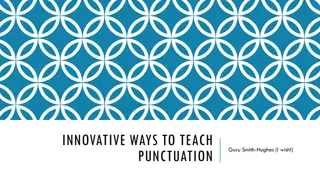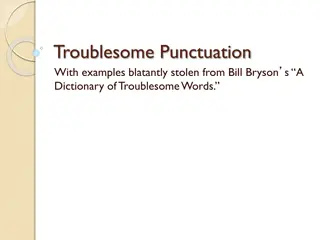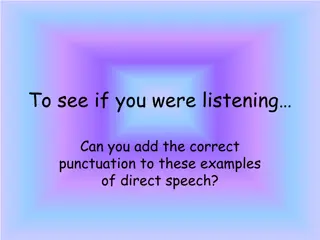Mastering Punctuation: Essential Rules and Usage Tips
Punctuation marks play a crucial role in organizing written language and conveying meaning accurately. This comprehensive guide covers the main punctuation marks such as full stops, question marks, exclamation marks, commas, semicolons, and colons. Learn how to effectively use these marks to enhance clarity, structure, and expressiveness in your writing.
Download Presentation

Please find below an Image/Link to download the presentation.
The content on the website is provided AS IS for your information and personal use only. It may not be sold, licensed, or shared on other websites without obtaining consent from the author.If you encounter any issues during the download, it is possible that the publisher has removed the file from their server.
You are allowed to download the files provided on this website for personal or commercial use, subject to the condition that they are used lawfully. All files are the property of their respective owners.
The content on the website is provided AS IS for your information and personal use only. It may not be sold, licensed, or shared on other websites without obtaining consent from the author.
E N D
Presentation Transcript
English Language Assistant Prof. Dr. Ahmed A. Mohammed
Punctuation Punctuation marks are symbols used to: 1. organize the structure of written language, and 2. to indicate intonation and pauses to be observed when reading aloud. *Punctuation marks are also used to avoid ambiguity. For example: woman, without her man, is nothing it has a different meaning from woman: without her, man is nothing
Summary of punctuation rules End punctuation marks: 1. Full stop , or period (.) Used at the end of a sentence: She stood up and went away. She was angry. Used for abbreviations: Co. = (Company) M.P. = (Member of Parliament) 2. Question marks (?) Question marks are used at the end of direct questions: Where do you live? Are you crazy? Did you do the homework?
Use a question mark at the end of tag questions: You will help me, won t you? He likes football, doesn t he? 3. Exclamation marks (!) Used to indicate strong emotions: She s so beautiful! What a nice girl! How interesting! Used after interjections: Oh! It s awful. Hi! What s up?
Other punctuation marks: Commas (,) Commas are used between items in a series or list. The last two items of the series usually do not need a comma between them. They are separated by (and): I like spaghetti, fish, pizza and Kentucky. Commas are also used between adjectives or adverbs: I'd like to have a big, black, German car. She speaks slowly, quietly and fluently. After the street address and city in an address: 34 Hassan II Street, Rabat, Morocco.
Before or after direct speech: He said, I hate being treated like that. I msorry , she replied. Before a coordinating conjunction (for, and, nor, but, or, yet, so): He woke up late, so he had to drive to work. Semicolons (;) Semicolons are used instead of a full stop or period to separate independent sentences: They woke up early; then they went jogging.
Use a semicolon to separate items in a series when those items contain punctuation such as a comma: They visited the Eiffel Tower, Paris; Big Ben, London; and the statue of liberty, New York. Colons (:) Use a colon to introduce a list: He visited three cities last summer holiday: Madrid, Roma and Athens. To introduce an idea or an explanation: He had one idea in mind: to see her as soon as possible.
To introduce direct speech or a quotation: The secretary whispered in his ear: Your wife is on the phone. Apostrophes ( ) Use an apostrophe to indicate a missing letter or letters in a contraction: I m fed up with his stories Use an apostrophe plus the letter s to show possession: My sister s friend is such a sweet girl.
Quotation marks () Quotation marks are used to quote speech, sentences or words: She said, I love you. Capitalization rules Capitalization is the writing of a word with the first letter as upper-case letter (A, B, C, D,...) and the rest of the word as lower-case letters (a, b, c, d,...) Summary of the capitalization rules Capitalize the first word in a sentence: They arrived late. They had dinner and went to sleep.
The first word in a quote: He said, You are fantastic. Capitalize I : I'm very sorry for being late. I missed the bus. Capitalize proper nouns: George was furious when he heard the bad news from Alice. Capitalize names of rivers, mountains: The Nile River is in Egypt. The highest mountain in the world is Mount Everest.
The official title of a person, the initials of someone's name are capitalized: Dr. Mohammed W. Shakespeare (William Shakespeare) is a wonderful novelist Capitalize countries, cities, languages, nationalities: New York is more exciting than Seattle. He lives in London, but he s not English. He s Iraqi. He speaks English, French in addition to Arabic. Days of the week, months of the year, holidays are capitalized: We went to Paris on Monday and came back on Saturday. The Independence Day is in July not January.
Writing tips Good writers usually use plain English words. So your sentences should be simple, clear and well structured. When writing, remember recommendations in mind: use simple language the following use simple and clear sentences write well structured paragraphs (with a topic sentences supporting details and a concluding sentence) you may use subordinate clauses but keep them short avoid slang language.
Paragraph As to paragraphs, keep the following rules in mind: Concentrate on one main point per paragraph. Summarize this point in the first sentence (topic sentence.) All sentences that follow support the main point or limit its scope (supporting sentences) The last sentence is a summary of the main point of the paragraph and is used as a transition to the next paragraph. (concluding sentence)
Text The typical structure of a text is as follows: Title introduction main part conclusion Make your texts interesting. Vary the lengths of your sentences. Use a short sentence to put emphasis on an important statement. Vary the lengths of your paragraphs and avoid one-sentence paragraphs. There are various possibilities on how to structure your texts, e.g.:
General to Specific: general statement followed by details and examples Specific to General: details and examples followed by a generalization: Known to Unknown: provide new information based on what readers already know Least Important to Most Important: catch and keep readers attention Chronology (ordering by time): e.g. in biographies
Process writing Successful writers follow these steps in their writing: Collecting the data Organizing the data Making an outline. The first draft. Editing. Possible reassessment of the ideas (crossing out some ideas, introducing new ideas, rearranging ideas ) Final draft.
1. Expressing addition To add information, you can use these expressions: Examples: in addition, - as well as - moreover - what is more - not only...but also... - furthermore - besides - also - too - and... If the project fails this will have terrible consequences not only on our department, but also on the whole organization John s grades are terrible because he has been so lazy these days. In addition to this, his relationship to his parents got worse. The report is badly written. Moreover, it s inaccurate.
2. Expressing contrast To express contrast, you can use these expressions: Examples: although - even though - in spite of / despite - however - yet - nevertheless - nonetheless - on the contrary - whereas - on the one hand ...but on the other hand... - conversely - but... Brain drain has terrible consequences on the developing countries. Nevertheless, nothing has been done to solve the problem or at least reduce its negative effects. In spite of / despiteFred s old age, he goes jogging every morning. Althoughshe s very nice, her classmates hate her.
They have got two children, a boy and girl. The boy takes after his father whereas the girl takes after the mother. 3. Expressing cause and effect To express cause and effect, you can use these expressions: Examples: consequently - as a consequence - as a result - therefore - because of this - for this reason - because - since - as - for - due to - owing to She remained silent, for she was so depressed to talk. We can t go to Sue s party because we ll be busy working on our project.
The plane was delayed because of the foggy weather. He had spent most of his time hanging around instead of revising his lessons. Consequently, he had a lot of trouble answering the exam questions. 4. Expressing purpose To express purpose use the following words: Examples: in order to - in order not to - so as to - so as not to - to - not to She wakes up early in order to be on time to work. They visited him so as to offer their condolences for the death of his wife
He helped the new policewoman so as not to fail in her first mission. 5. Summarizing To summarize, you can use the following expressions: in conclusion - to conclude - to sum up - in a nutshell - in brief - in short - all in all - everything considered...
Useful Academic Expressions 1. Stating your own position on a Subject or Topic This paper aims at... This paper will be concerned with... The aim of this paper is to The view presented in this paper/essay/review is that.. 2. Presenting your own point of view I strongly believe that... To my mind... As I see it.... There are many reasons why It is important/necessary to point out that The first thing to be considered is
3. Supporting your view and adding more information The first/second reason why is Firstly/Secondly... not only ...but also... The most important In addition, Furthermore, Another reason is A further point is
4. Stating the view of Another Person on a Subject or Topic Chomsky (1965, p. 133) argues/claims/points out that... Th authors views can be stated as follows... The opinion of Chomsky (1965, p. 133) is that Chomsky (1965, p. 133) has suggested that . According to Smith (1992, p. 123),
5. Agreeing with the Views of Others As Chomsky (1965, p. 133) says/states Like Chomsky (1965, p. 133), it can be agreed that . because There is a general agreement about... 7. Indicating a Lack of Knowledge in a Particular Topic or Subject Despite the book s attempts to... it lacks accuracy... Although the research has tended to focus on ..., less attention has been paid to Most studies, such as Harris (1970, p. 1) and Chomsky (1965, p. 133) have emphasized/concentrated on/focused on inadequate /insufficient .
8. Drawing a Conclusion Using the Work of Others To sum up, ... As a conclusion, ... As a summary, ... All in all, ... To conclude, ... Based on these authors, a connection can be made between It can be concluded from what Jones (2004, p. 2) and Smith (2002, p. 1) have stated that...
How to define concepts . can be defined as .. . can be described as . refers to .. . means What are conversation fillers? During a conversation, silence can be embarrassing. In order to keep the conversation going, it is recommended to use conversation fillers. These are words, phrases or simply sounds that we use to actively listen to someone speaking or to give
ourselves thinking time before we answer a question, especially if we don't understand it. Conversation fillers fall under the category of formulaic language that we retrieve from memory to sound fluent. Conversation fillers will help you sound fluent like a native speaker. Here are some examples of conversation fillers While listening: Really? Right Sure How awful! Oh no! You re joking! What a pity!
Auxiliary verbs to make short questions as in: -Have you? -did you? -Is it? Non-words, as in: -mmm -uh-huh... While speaking: Well Ok So Let me think... I mean I guess/think You know
What I want to say is Anyway, Well, what I mean is Back to our topic As I was saying The basic idea is























